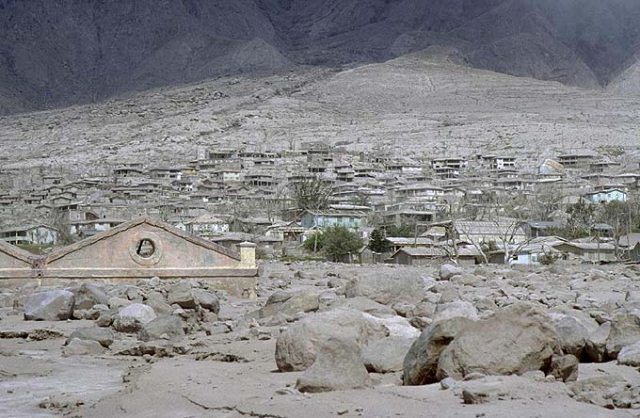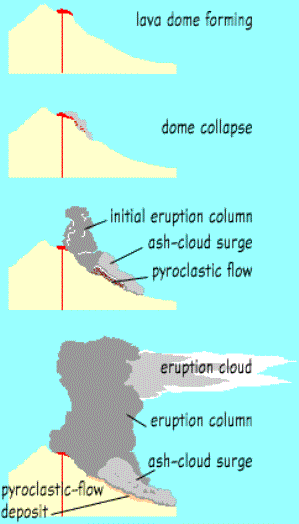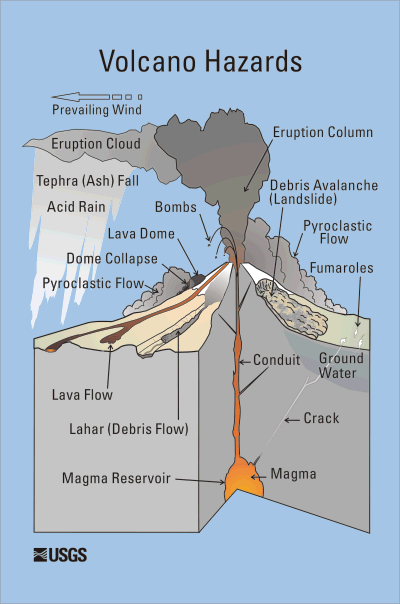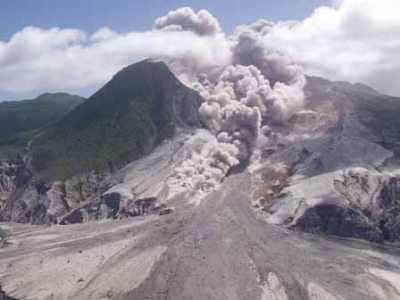Pyroclastic Flow

|
Pyroclastic flow
A pyroclastic flow (also known scientifically as a pyroclastic density current) is a fast-moving current of extremely hot gas which can reach temperatures of about one thousand degrees centigrade and rock (collectively known as tephra, which travel away from a volcano at speeds generally as great as four hundred and fifty miles per hour. The flows normally hug the ground and travel downhill, or spread laterally under gravity. Their speed depends upon the density of the current, the volcanic output rate, and the gradient of the slope. They are a common and devastating result of certain explosive volcanic eruptions. The word pyroclast is derived from the Greek meaning "fire" and "broken in pieces". A name for some pyroclastic flows is nuée ardente (French for "glowing cloud"); this was first used to describe the disastrous 1902 eruption of Mount Pelee on Martinique. These pyroclastic flows glowed red in the dark. It may not look as sexy as the red flowing lava we see in movies but the devastation is just as great, but no diamonds from this stuff.
 Pyroclastic flows that contain a much higher proportion of gas to rock are known as "fully dilute pyroclastic density currents" or pyroclastic surges. The lower density sometimes allows them to flow over higher topographic features such as ridges and hills. They may also contain steam, water and rock at less than two hundred and fifty degrees centigrade; these are called "cold" compared with other flows, although the temperature is still lethally high. Cold pyroclastic surges can occur when the eruption is from a vent under a shallow lake or the sea. Fronts of some pyroclastic density currents are fully dilute; for example, during the eruption of Mount Pelee in 1902 a fully dilute current overwhelmed the city of Saint-Pierre and killed nearly thirty thousand people. A pyroclastic flow is a type of gravity current; in scientific literature they are sometimes abbreviated to PDC (pyroclastic density current).
  Causes: There are several scenarios which can produce a pyroclastic
flow:
 Size and effects: The volumes range from a few hundred cubic meters to more than a
thousand cubic kilometres. The larger ones can travel for hundreds of
kilometres, although none on that scale have occurred for several hundred
thousand years. Most pyroclastic flows are around one to ten cubic kilometers
and travel for several kilometres. Flows usually consist of two parts: the
basal flow hugs the ground and contains larger, coarse boulders and rock
fragments, while an extremely hot ash
plume lofts above it because of the turbulence between the flow and the
overlying air, admixes and heats cold atmospheric air causing expansion and
convection. The kinetic
energy of the moving boulders will flatten trees and buildings in their
path. The hot gases and high speed make them particularly
lethal:
 Interaction with water: Testimonial evidence from the 1883
eruption of Krakatoa, supported by experimental evidence, shows that pyroclastic flows
can cross significant bodies of water. One flow reached the Sumatran coast as much as thirty miles away. A recent documentary film, Ten Things You Didn't Know About
Volcanoes, demonstrated tests by a research team at Kiel
University, Germany, of pyroclastic flows moving over water. When the reconstructed
pyroclastic flow (stream of mostly hot ash with varying densities) hit the water
two things happened. The heavier material fell into the water, precipitating out
from the pyroclastic flow and into the liquid. This large displacement of heavy
ash into the water caused a displacement of water; in reality, this would cause
a tsunami due to the displacement via precipitate mass, as it did with the
Krakatoa eruption. The temperature of the ash caused the water to evaporate,
propelling the pyroclastic flow (now only consisting of the lighter material)
along at an even faster pace than before on a bed of
steam. On the Moon: In 1963, NASA astronomer Winifred Cameron proposed that sinuous rilles on the Moon may have been formed by the lunar equivalent of terrestrial pyroclastic flows. In a lunar volcanic eruption, a pyroclastic cloud would follow local relief resulting in an often sinuous track. The Moon's Schroter's Valley is one example.

ALL IN ALL DEVASTATING |
